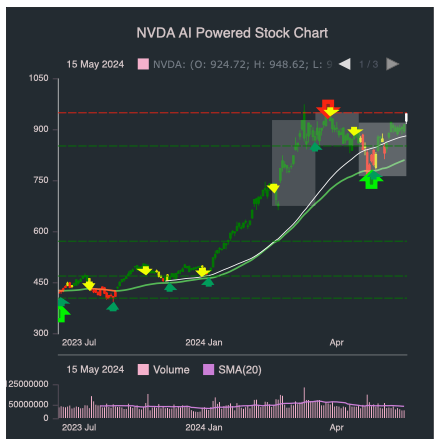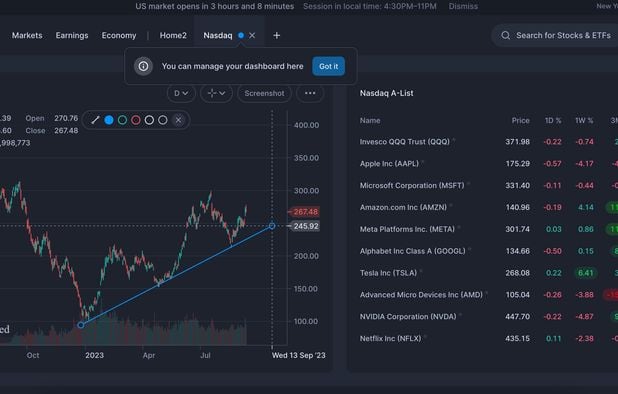20 New Ways For Choosing AI Stock Prediction Websites
20 New Ways For Choosing AI Stock Prediction Websites
Blog Article
Top 10 Suggestions For Evaluating The User Interface And Experience Ai Analysis And Prediction Of Trading Stocks
The User Interface (UI) and User Experience (UX) of AI trading platforms that predict and analyze stocks are essential to ensuring usability, efficiency and general satisfaction. A poorly-designed interface can inhibit decision-making, even if AI models underlying it are robust. Here are 10 ways on how to evaluate the UX/UI.
1. The user-friendliness and the intuitiveness of the product are assessed
Navigation: Make the platform easy to use by clearly defining menus of buttons and workflows.
Learning curve: Evaluate the speed at which a novice user can understand and use the platform without extensive training.
Verify uniformity in design patterns across platforms (e.g. buttons styles or colour schemes, etc.).).
2. Check for Customizability
Dashboard customization - Make sure that dashboards are customizable by users using pertinent charts, metrics and data.
Layout flexibility: Ensure that the platform allows users to rearrange or resize widgets or charts. Tables, tables, and charts.
Themes and preferences: Check whether the platform supports dark and light modes, or other preferences.
3. Review the data Visualization
Quality of the chart: Make sure that the platform offers high-quality, interactive charts (e.g. line charts, candlestick charts) with pan and zoom capabilities.
Visual clarity - Check to determine if the data are clearly displayed, using the appropriate tools, labels or legends.
Real-time updates: Check if the visualizations are updated in real time to reflect the latest developments on the market.
4. Test for Reactivity and Speed
Time to load: Make sure your platform loads fast regardless of handling huge datasets or complex calculations.
Real-time performance: Confirm that the platform is able to handle data feeds in real-time without lags or delays.
Cross-device compatibility : Make sure that your device is compatible with the platform (desktops mobiles, tablets, desktops).
5. Evaluate accessibility
Mobile App: Make sure the platform provides a mobile trading app that is fully functional.
Keyboard shortcuts: Make sure the platform supports keyboard shortcuts to the most powerful users.
Accessibility features. Verify the platform's compliance with accessibility standards.
6. Review the search and filtering functionality
Search effectiveness: The platform must enable users to search quickly for indexes, stocks and other assets.
Advanced filters - Find out if users are able to apply filters, for instance by sector, market cap or performance metrics, to limit the results.
Saved searches: See whether you can save searches and filters that you frequently use.
7. Be sure to check for alerts or notifications
Alerts that can be customized: Make sure users are able to set up alerts for specific conditions (e.g. prices thresholds, spikes in volume news events).
Notification delivery: Make sure that notifications are delivered via multiple methods, e.g. SMS, email or in-app notifications.
Timing - Ensure that alerts are issued quickly and accurately.
8. Evaluation of Integration with Other Software
Broker integration - Check that your platform seamlessly integrates with your brokerage to allow rapid trade execution.
API access: Discover if advanced users can access the API to create their own customized tools or workflows.
Third-party platforms: Examine to find out if your platform has the ability to integrate with other applications (such as Excel, Google Sheets or trading bots).
9. Assessment Help and Support Features
Tutorials on boarding: See whether the platform has tutorials or walkthroughs to new users.
Help center. Check that your platform comes with an extensive help center.
Support for customers - Find out if the platform offers responsive support (e.g. email, live chat).
10. Test Customer Satisfaction Overall
User feedback: Use reviews and testimonials of users to gauge their overall satisfaction with the platform's UI/UX.
Trial time: You can use a demo or free trial period to test the platform and test its usability.
Verify that the error handling is correct.
Bonus Tips
Aesthetics. While function may be the most important element, an attractive design can enhance your overall experience.
Performance under stress: Test your platform in highly volatile markets to ensure it's responsive and stable.
Check the community and forums to see if there is a user group that allows users to exchange tips and feedback.
Use these suggestions and you can assess the UI/UX of AI-powered stock prediction/analysis trading platforms. They'll be user-friendly efficient, and effective, and also suited to your needs in trading. The user interface and experience of a trading platform can have a significant impact on the ability of you to make informed trades and make the right choices. View the most popular ai investing advice for site advice including ai for stock predictions, ai trading tools, using ai to trade stocks, ai chart analysis, ai for investing, best ai trading software, investing ai, trading ai, best ai for trading, ai investment app and more.
Top 10 Suggestions For Evaluating The Speed And Latency In Ai Platform For Analyzing And Stock Predicting
Speed and latency is crucial when it comes to evaluating AI stock prediction/analyzing trading platforms. This is especially true for high-frequency traders, algorithmic traders as well as active traders. Milliseconds of delay could negatively impact profitability and trade execution. Here are the top ten strategies for evaluating speed and latency on these platforms:
1. Real-time data feeds: How to analyze them
Speed of delivery of data - Ensure that the platform will provide real-time data with a minimum delay (e.g. an under-millisecond latency).
Data source proximity - Look to determine if the servers on your platform are within major exchanges. This will cut down on the time for data transmission.
Data compression: Find out whether your platform uses efficient data compression techniques to speed up the speed of data transfer.
2. Time to test trade execution
The time it takes to process your order is the time of your order that will be processed and completed through the platform.
Direct Market Access (DMA) Check to see if the platform you are using supports DMA. This allows orders to be sent directly to the exchange without the necessity of intermediaries.
Make sure you have a detailed report on the execution that includes timestamps as well as confirmations of the order.
3. Assess the response of the platform
User interface (UI) speed: Check the speed at which the UI of your platform responds to your inputs (e.g. pressing buttons, loading charts).
Chart updates: Verify that charts and visualisations are updated in real-time and without delay.
The performance of mobile apps: If you use a mobile app on your phone, be sure that it runs as fast as the desktop version.
4. Check for Low-Latency infrastructure
Server Locations: Ensure that the platform has servers with low latency located near major hubs for financial exchanges or financial hubs.
Look for colocation alternatives. These services permit you to place your algorithms near the exchange.
High-speed network: Verify whether the platform uses high-speed fibre-optic networks or other technologies with low latency.
5. Assess the Backtesting and Simulation speed
Historical data processing: Check the speed at which your platform analyzes and processes historical data.
Simultaneous simulation of trades The platform should be capable of simulated live trading with no apparent delays.
Parallel processing: Determine whether your platform supports parallel processing or distributed computing to speed up complex calculations.
6. Check the API Latency
API response time Measuring how quickly the platform's API responds (e.g. retrieving market data, or placing orders).
Rate limits. Verify whether there are acceptable limits on the API. This will help prevent delays in high-frequency transactions.
WebSocket support - Check to see if your system is running the WebSocket protocol for low-latency real-time streaming of data.
7. Test stability of the platform under load
Create scenarios for high-volume trading to see whether the platform is reliable and stable.
Check your platform out during times of high market volatility.
Utilize the tools available on the platform to test your strategies in extreme conditions.
8. Review Connectivity and Network
Internet speed requirements: Make sure your connection is up to the recommended platform speed.
Reliable connections: Check whether your platform has redundant internet connections. This will help you avoid the possibility of downtime.
VPN latency. Verify if you are using a VPN to determine if it causes latency.
9. Check for Speed Optimization Features
Pre-trade analyses The platform must provide pre-trade analyses to optimize the speed of execution and routing of orders.
Smart order routing: Find out whether your platform uses SOR to locate the fastest and most cost-effective execution location.
Monitoring latency: Check whether your platform is equipped with tools that let you analyze and monitor latency real-time.
Review Benchmarks and User Feedback
Reviews from users: Perform user studies to determine the platform's speed and latency.
Third-party benchmarks from third-party. Look for independent benchmarks, or reviews that compare the speed of a platform with other platforms.
Case studies: Verify if a platform has cases studies or testimonials which highlight the features that are low-latency.
Bonus Tips:
Trial period: Try out an unpaid test or demo version of the platform to test how it performs in real situations.
Customer Support: Verify that the platform can offer assistance with issues related to latency, or optimize.
Hardware requirements. Check if the platform is compatible with a specific type of hardware for example, high-performance computers.
Utilizing these guidelines, it is possible to precisely assess the speed, latency and accuracy of AI analysis and stock prediction systems. This allows you to select a platform based on your trading requirements as well as reducing any delay. A low latency is crucial for high-frequency and algorithmic traders, where even small delays can significantly impact profitability. Take a look at the top best AI stocks for site advice including stock predictor, ai in stock market, AI stock predictions, can ai predict stock market, ai options, ai for trading stocks, trading ai tool, ai copyright signals, AI stock price prediction, free ai tool for stock market india and more.